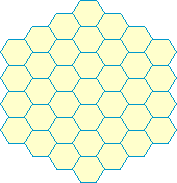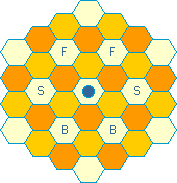Who's Online
We have 107 guests and no members online
Hexagonal variants
The hexgrid
 diagram 1 |  diagram 2 |  diagram 3 |  diagram 4 |
In (1) and (2) the diagonal grids are divided in a red and a blue half. Removing the blue half from each brings us to (3) and (4). In (3) we recognize the motherboard of them all, the Alquerque board. Its twin (4) is the 'triangular' grid, albeit in a square jacket. But topologically (4) is equivalent to the hexgrid:
 diagram 5 |  diagram 6 |
In (5) we see the square with one set of diagonals on the right. On the left it has been modelled into a grid of equilateral triangles, the 'dual' of which is the hexgrid (6).
The hexgrid, like its twin the 'alquerque grid', is thus equivalent with a square grid with one added set of diagonals. Games following these lines may therefore be considered partial doublegrid games.
Since the two straight directions and the one diagonal direction of (4) have become equivalent in the hexgrid (6), a game following these lines may also be considered as a singlegrid game with three forward and three backwards directions. The character of such a game however, will always be that of a partial doublegrid game.
The checkered hexgrid - subgrids
Like the square grid, the hexgrid can be checkered, but with three rather than two shades:
 diagram 7 |  diagram 8 |
